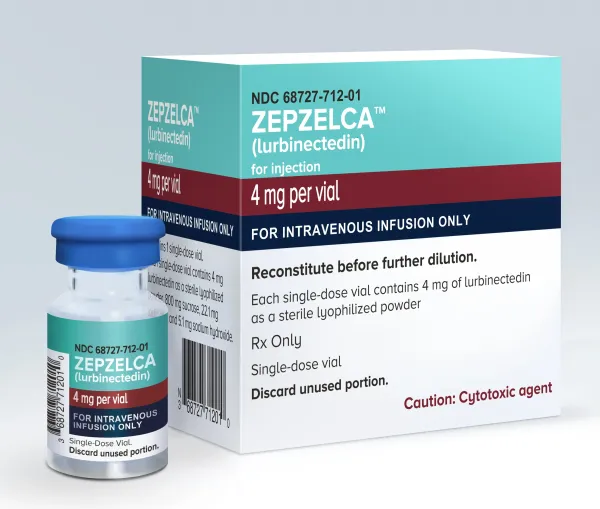Lurbinectedin Side Effects
Medically reviewed by Drugs.com. Last updated on Jan 12, 2025.
Applies to lurbinectedin: intravenous powder for solution.
Serious side effects of lurbinectedin
Along with its needed effects, lurbinectedin may cause some unwanted effects. Although not all of these side effects may occur, if they do occur they may need medical attention.
Check with your doctor or nurse immediately if any of the following side effects occur while taking lurbinectedin:
More common side effects
- black, tarry stools
- bleeding gums
- bloody urine
- bone, joint, or muscle pain
- chest pain or tightness
- chills
- dark urine
- difficult or labored breathing
- fever
- general feeling of discomfort or illness
- hoarseness
- loss of appetite
- lower back or side pain
- nausea
- painful or difficult urination
- pale skin
- pale stools
- pinpoint red spots on the skin
- sneezing
- sore throat
- stomach pain or tenderness
- thickening of bronchial secretions
- trouble breathing
- ulcers, sores, or white spots in the mouth
- unusual bleeding or bruising
- unusual tiredness or weakness
- vomiting
- yellow eyes or skin
Less common side effects
- swelling of the feet or lower legs
Incidence not known
- muscle cramps, spasms, or stiffness
- pain, discomfort, itching, redness, or swelling at the injection site
Other side effects of lurbinectedin
Some side effects of lurbinectedin may occur that usually do not need medical attention. These side effects may go away during treatment as your body adjusts to the medicine. Also, your health care professional may be able to tell you about ways to prevent or reduce some of these side effects.
Check with your health care professional if any of the following side effects continue or are bothersome or if you have any questions about them:
More common side effects
- burning, numbness, tingling, or painful sensations
- change in or loss of taste
- constipation
- diarrhea
- headache
- unsteadiness or awkwardness
For healthcare professionals
Applies to lurbinectedin: intravenous powder for injection.
General adverse events
The most common adverse reactions (20% or more), including laboratory abnormalities, were leukopenia, lymphopenia, fatigue, anemia, neutropenia, increased creatinine, increased alanine aminotransferase, increased glucose, thrombocytopenia, nausea, decreased appetite, musculoskeletal pain, decreased albumin, constipation, dyspnea, decreased sodium, increased aspartate aminotransferase, vomiting, cough, decreased magnesium, and diarrhea.[Ref]
Cardiovascular
- Very common (10% or more): Chest pain (up to 10%)[Ref]
Gastrointestinal
- Very common (10% or more): Nausea (up to 37%), constipation (up to 31%), vomiting (up to 22%), diarrhea (up to 20%), abdominal pain (up to 11%)[Ref]
Abdominal pain included upper abdominal pain and abdominal discomfort[Ref]
Hematologic
- Very common (10% or more): Decreased leukocytes (up to 79%), decreased lymphocytes (up to 79%), decreased hemoglobin (up to 74%), decreased neutrophils (up to 71%), decreased platelets (up to 37%)
- Frequency not reported: Neutropenia, febrile neutropenia, anemia, thrombocytopenia[Ref]
Hepatic
- Very common (10% or more): Increased ALT (up to 66%), increased AST (up to 26%)[Ref]
Local
- Postmarketing reports: Extravasation including tissue necrosis requiring debridement[Ref]
Metabolic
- Very common (10% or more): Decreased appetite (up to 33%), increased glucose (up to 52%)
- Postmarketing reports: Tumor lysis syndrome[Ref]
Musculoskeletal
- Very common (10% or more): Musculoskeletal pain (up to 33%)
- Postmarketing reports: Rhabdomyolysis[Ref]
Musculoskeletal pains included back pain, arthralgia, pain in extremity, musculoskeletal chest pain, neck pain, bone pain, and myalgia.[Ref]
Nervous system
- Very common (10% or more): Peripheral neuropathy (up to 11%), headache (up to 10%)
- Frequency not reported: Dysgeusia[Ref]
Peripheral neuropathy included neuralgia, paresthesia, peripheral sensory neuropathy, hypoesthesia, and hyperesthesia.[Ref]
Other
- Very common (10% or more): Fatigue (up to 77%), pyrexia (up to 13%), decreased albumin (up to 32%), decreased sodium (up to 31%), decreased magnesium (up to 22%)[Ref]
Renal
- Very common (10% or more): Increased creatinine (up to 69%)[Ref]
Respiratory
- Very common (10% or more): Dyspnea (up to 31%), cough including productive cough (up to 20%), respiratory tract infection (up to 18%), pneumonia including lung infection (up to 10%)
- Frequency not reported: Pneumonitis[Ref]
Respiratory tract infection included upper respiratory tract infection, viral respiratory tract infection, and bronchitis.[Ref]
References
1. (2020) "Product Information. Zepzelca (lurbinectedin)." Jazz Pharmaceuticals
2. (2021) "Product Information. Zepzelca (lurbinectedin)." Specialised Therapeutics Pharma Pty Ltd
More about lurbinectedin
- Check interactions
- Compare alternatives
- Dosage information
- During pregnancy
- Drug class: alkylating agents
- En español
Patient resources
Other brands
Professional resources
Other brands
Related treatment guides
Further information
Lurbinectedin side effects can vary depending on the individual. Always consult your healthcare provider to ensure the information displayed on this page applies to your personal circumstances.
Note: Medication side effects may be underreported. If you are experiencing side effects that are not listed, submit a report to the FDA by following this guide.

